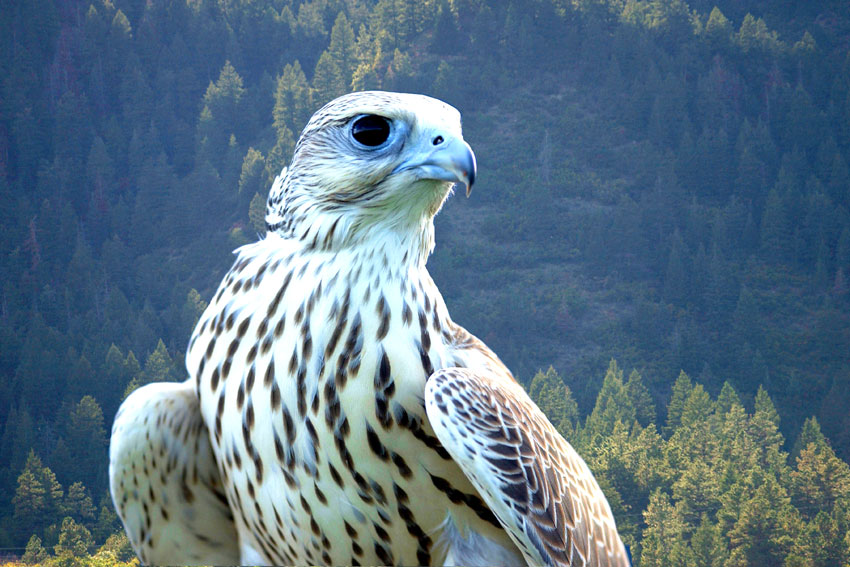- Hierofalcon
Taxobox
name = Hierofalcons

image_width = 250px
image_caption = "Yeti", a hybrid whitegyrfalcon ×saker falcon . Hierofalcons hybridize readily, and offspring are often fully fertile.
regnum =Animal ia
phylum =Chordata
classis =Aves
ordo =Falconiformes
familia =Falconidae
genus = "Falco"
subgenus = "Hierofalco"
subgenus_authority = Cuvier,1817
subdivision_ranks =Species
subdivision ="Falco biarmicus "
"Falco cherrug "
"Falco jugger "
"Falco rusticolus "
synonyms ="Jerafalco" Kaup,1850 (unjustified emendation)
"Falco hierofalco" (see text)The hierofalcons (literally, "hawk-falcons") are four closely related species of
falcon which make up thesubgenus "Hierofalco":*
Lanner Falcon , "Falco biarmicus"
*Laggar Falcon , "Falco jugger"
*Saker Falcon , "Falco cherrug"
*Gyrfalcon , "Falco rusticolus"The
Black Falcon ofAustralia is occasionally considered allied to the hierofalcons: indeed it seems fairly close to them (Wink "et al." 2004).They represent members of their
genus which are similar to species like thePeregrine Falcon in outward appearance, but usually with morephaeomelanin s which impart reddish or brown colors, and generally more strongly patterned plumage reminiscent ofhawk s. Their undersides usually have a lengthwise pattern of dark blotches, lines or arrowhead marks. They hunt usually in level flight, more likegoshawk s than Peregrines with their dive attack or hobbies with their acrobatic pursuits.Recent
DNA sequence data studies have confirmed that the hierofalcons are amonophyletic group - and, incidentally, thathybridization runs rampant in the present species complex. Initial results ofmtDNA cytochrome "b" sequence analyses that suggested they are basal among all living falcons were in error, due to anumt (Wink & Sauer-Gürth 2000). Thebiogeographical ly entirely distinctPrairie Falcon was sometimes placed with the hierofalcons due to its similar coloration; it is now considered not to belong in this subgenus, the similarities being the result ofconvergent evolution in adaptation to similarhabitat .The hierofalcon lineage as such seems of
Late Pliocene origin, maybe as old as the "typical"kestrel s (Gelasian , some 2.5-2 million years ago [Wink & Sauer-Gürth (2000), Groombridge "et al." (2002)] ), maybe somewhat older, though little is known about their fossil history. It seems to have originated inAfrica or adjacent regions but apparently became nearly extinct in the past: the present hierofalcon diversity is of rather recent origin, presumably not older than theEemian interglacial (about 130,000-115,000 years ago) at the start of theLate Pleistocene ; only one of the hierofalcon species that presumably diverged between the Pliocene and theMiddle Pleistocene has left any living descendants. TheLanner Falcon appears to be the mostphylogenetic ally most ancient species (mainly judging frombiogeography ); the others diverged - apparently out of a population isolated in northeastern Africa some time during theRiss glaciation 200,000 to 130,000 years ago - in a brief and rapid bout of evolution. DNA sequence data analyses in this group suffers from the extensive hybridization and incompletelineage sorting confounding the data, and studies with smallsample size s can by no means be considered reliable. Sometimes, all hierofalcons are lumped into one species, "Falco hierofalco". [Helbig "et al." (1994), Wink "et al." (1998), Groombridge "et al." (2002), Wink "et al." (2004), Nittinger "et al." (2005)]Possible examples of such extinct hierofalcon lineages include an unnamed "Falco" species occurring from the
Early Pliocene of Bulgaria toEarly Pleistocene of Spain and Czechia [Similar to theSaker Falcon (Mlíkovský 2002), but a relationship e.g. with thePeregrine Falcon cannot be dismissed. Due to the large time interval, it might be more than one species.] and "Falco antiquus" known from the Middle Pleistocene of Noailles (France ) and possiblyHorvőlgy (Hungary ) [Very similar to theSaker Falcon and classified as apaleosubspecies of that species by Mlíkovský (2002). Not too likely due to the probably more recent origin of the Saker (Nittinger "et al." 2005).] .Footnotes
References
* (1999): Phylogeny of the Falconidae inferred from molecular and morphological data. "Auk" 116(1): 116–130. [http://elibrary.unm.edu/sora/Auk/v116n01/p0116-p0130.pdf PDF fulltext]
* (2002): A molecular phylogeny of African kestrels with reference to divergence across the Indian Ocean. "Molecular Phylogenetics and Evolution" 25(2): 267–277. DOI|10.1016/S1055-7903(02)00254-3 (HTML abstract)
* (1994): Phylogenetic relationships among falcon species (genus Falco) according to DNA sequence variation of the cytochrome b gene. "In:" aut|Meyburg, B.-U. & Chancellor, R.D. (eds.): "Raptor conservation today": 593-599. [http://www.uni-heidelberg.de/institute/fak14/ipmb/phazb/pubwink/1994/4.%201994.pdf PDF fulltext]
* (2005): Out of Africa? Phylogenetic relationships between "Falco biarmicus" and other hierofalcons (Aves Falconidae). "Journal of Zoological Systematics and Evolutionary Research" 43(4): 321-331. doi|10.1111/j.1439-0469.2005.00326.x [http://www.uni-heidelberg.de/institute/fak14/ipmb/phazb/pubwink/2005/28.2005.pdf PDF fulltext]
* (2000): Advances in the molecular systematics of African raptors. "In:" aut|Chancellor, R.D. & Meyburg, B.-U. (eds): "Raptors at Risk": 135-147. WWGBP/Hancock House, Berlin/Blaine. [http://www.uni-heidelberg.de/institute/fak14/ipmb/phazb/pubwink/2000/29.%202000.pdf PDF fulltext]
* (1998): Molecular systematics of holarctic raptors (Order Falconiformes). "In:" aut|Chancellor, R.D., Meyburg, B.-U. & Ferrero, J.J. (eds.): "Holarctic Birds of Prey": 29-48. Adenex & WWGBP. [http://www.uni-heidelberg.de/institute/fak14/ipmb/phazb/pubwink/1998/31.%201998.pdf PDF fulltext]
* (2004): Phylogenetic relationships in the Hierofalco complex (Saker-, Gyr-, Lanner-, Laggar Falcon). "In:" aut|Chancellor, R.D. & Meyburg, B.-U. (eds.): "Raptors Worldwide": 499-504. WWGBP, Berlin. [http://www.uni-heidelberg.de/institute/fak14/ipmb/phazb/pubwink/2004/27.2004.pdf PDF fulltext]
Wikimedia Foundation. 2010.
